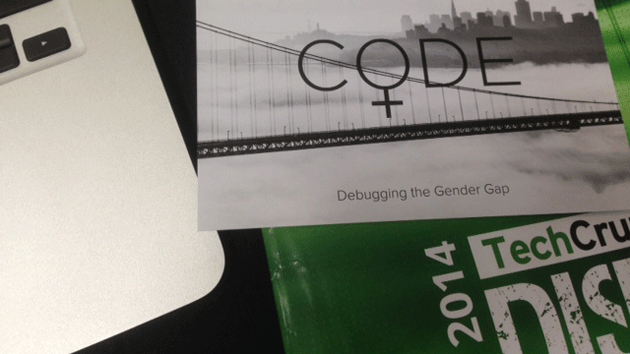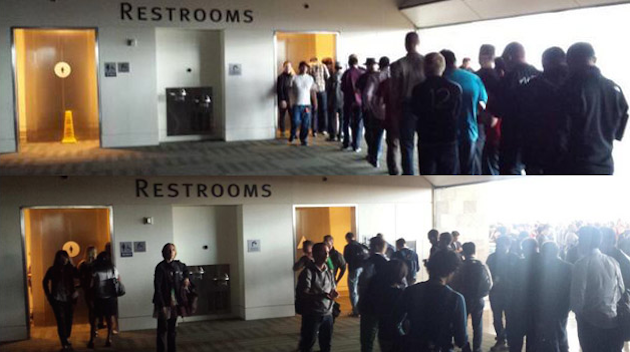
The bathroom line at TechCrunch Disrupt yesterdayJosh Harkinson
The TechCrunch Disrupt conference now underway in San Francisco is arguably the most important annual gathering for tech startups. It’s also a notoriously hostile environment for women, as made clear by last year’s conference, whose hackathon produced an app called “Titstare,” which let the user “take photos of yourself staring at tits,” not to mention “Circle Shake,” an app that measures how fast guys can masturbate. The TC Disrupt crowd tends to be 80 to 90 percent male, as you might infer from my bathroom-line photo yesterday. Mike Judge lampooned the conference’s “brogrammer” vibe in his HBO comedy series, Silicon Valley.
This year, the organizers of TechCrunch Disrupt have worked to prevent an embarrassing repeat of the Titstare debacle by publishing and enforcing a detailed “anti-harassment policy.” An attendee of this weekend’s hackathon told me that TechCrunch cited the policy when it quietly nixed a plan by a group of hackers to create a “Bitcoin for strippers” app. Even so, TechCrunch hasn’t been able to completely scrub the event of everything that might be perceived as sexist. This morning, for example, guys entering the conference were mobbed and hugged by groups of women shouting “Groopie!”—they’d been hired to promote a mobile video app:
The app Groopie has hired women to jump on #tcdisrupt patrons and shout “groopie!” while snapping photos. pic.twitter.com/5GJ8tMZwr4
— Josh Harkinson (@JoshHarkinson) September 9, 2014
Here’s a video of the Groopie girls in action at #tcdisrupt. What do women techies think of this? https://t.co/9T4mby23RK
— Josh Harkinson (@JoshHarkinson) September 9, 2014
“I don’t really see the point of booth babes,” says Jenna Williams, a recruiter for the smart-home company leeo, a major outlier in that 40 percent of its tech employees are women. “If they get a question about the technology and can’t answer it, it’s not a good way to represent your product.”
Anne Ward, a software developer, SEO expert, and marketer attending TC Disrupt for the third year, says men at tech conferences often assume that she’s not a code jockey, and they expect her to prove her tech chops when she insists otherwise. She counsels younger female techies on how to navigate the conference scene: Don’t be surprised when male geeks mistake professional interest for personal interest. And if they try to quiz your tech chops by dropping a lot of coding acronyms, just say: “Oh, I see we are using TLAs (three-letter acronyms) instead of having a real conversation.”
(One woman who literally wrote the book on coding recently wrote a hilarious Medium post about this sort of thing, culled from the anonymous gossip site Secret).
To its credit, TC Disrupt has drawn a slightly larger proportion of women this year, according to longtime attendees. Yesterday, a panel of venture capitalists discussed the gender gap onstage for a few minutes, and several panels have featured the female founders of prominent statups, such as Elizabeth Holmes of the blood test company Theranos. Today, the makers of a documentary about “debugging the gender gap” distributed flyers:

Still, several female techies told me that the conference organizers could do much more to help women play meaningful roles. The panel discussions, they said, felt like lip service—outlining the problem but offering few solutions. A better approach would be to “start pulling in women who are founders as keynote speakers,” says Hanna Aase, the founder of video-profile platform Wonderloop. “That’s what really shows the serious side of what we are doing.” (TechCrunch Disrupt doesn’t feature “keynote speakers,” but more than 80 percent of the people named in the printed conference agenda are men).
Ultimately, Ward says, more women will be willing to go into tech if they see others like themselves rising to the top. Earlier this year, she spoke on a “women in engineering” panel at Developer Week. “I saw tears in the eyes of women in the audience,” she says. “It was seeing them be lifted up instead of put down. Like, ‘Oh, wait, I should be here.'”














